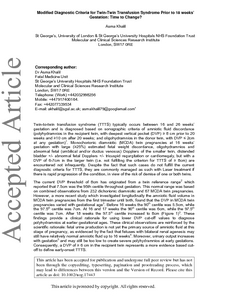Khalil, A
(2017)
Modified Diagnostic Criteria for Twin-Twin Transfusion Syndrome Prior to 18 weeks' Gestation: Time to Change?
Ultrasound Obstet Gynecol, 49 (6).
pp. 804-805.
ISSN 1469-0705
https://doi.org/10.1002/uog.17443
SGUL Authors: Khalil, Asma
![[img]](https://openaccess.sgul.ac.uk/108667/7.hassmallThumbnailVersion/uog17443.pdf)  Preview |
|
PDF
Accepted Version
Available under License ["licenses_description_publisher" not defined].
Download (1MB)
| Preview
|
Abstract
Twin-to-twin transfusion syndrome (TTTS) typically occurs between 16 and 26 weeks' gestation and is diagnosed based on sonographic criteria of amniotic fluid discordance (polyhydramnios in the recipient twin, with deepest vertical pocket (DVP) ≥ 8 cm prior to 20 weeks and ≥10 cm after 20 weeks; and oligohydramnios in the donor twin, with DVP ≤ 2 cm at any gestation) (Eurofoetus@eurofoetus.org). Monochorionic diamniotic (MCDA) twin pregnancies at 16 weeks' gestation with large (≥25%) estimated fetal weight discordance, oligohydramnios and abnormal fetal (umbilical and/or ductus venosus) Dopplers of the smaller twin, distended bladder +/- abnormal fetal Dopplers +/- tricuspid regurgitation or cardiomegaly, but with a DVP of 6-7 cm in the larger twin (i.e. not fulfilling the criterion for TTTS of ≥ 8 cm) are encountered not infrequently. Despite the fact that such cases do not fulfill the current diagnostic criteria for TTTS, they are commonly managed as such with Laser treatment if there is rapid progression of the condition, in view of the risk of demise of one or both twins. The current DVP threshold of 8 cm has originated from a twin reference range1 which reported that 7.5 cm was the 95th centile throughout gestation. This normal range was based on combined observations from 232 dichorionic diamniotic and 67 MCDA twin pregnancies. However, a more recent study which investigated longitudinally the amniotic fluid volume in MCDA twin pregnancies from the first trimester until birth, found that the DVP in MCDA twin pregnancies varied with gestational age2. Before 16 weeks the 90th centile was 5.5 cm, while the 97.5th centile was 7 cm. At 16 and 17 weeks the 90th centile was 6 cm, while the 97.5th centile was 7 cm. After 18 weeks the 97.5th centile increased to 8 cm (Figure 1)2. These findings provide a clinical rationale for using lower DVP cut-off values to diagnose polyhydramnios at earlier gestational ages. These clinical observations are reinforced by the scientific rationale: fetal urine production is not yet the primary source of amniotic fluid at this stage of pregnancy, as evidenced by the fact that fetuses with bilateral renal agenesis may still have relatively normal amniotic fluid up to 16 weeks3. Moreover, urinary output increases with gestation4 and may still be too low to create severe polyhydramnios at early gestations. Consequently, a DVP of ≥ 6 cm in the recipient twin represents a more evidence based cut-off to define early-onset TTTS. The mismatch between the clinical/ultrasound assessment and the current diagnostic criteria has several clinical, research and legal implications. These cases might be exposed to worse outcomes as, according to current diagnostic criteria, they should not be managed as TTTS, so might not be offered prenatal intervention. Furthermore, some would be classified and managed as pregnancies complicated by selective fetal growth restriction, which has a different outcome, counselling and management to that of TTTS. Moreover, these cases might not feature in TTTS research studies as they do not fulfill the current diagnostic criteria, risking erroneous conclusions and recommendations. It is time to pay attention to these pregnancies presenting before 18 weeks' gestation with features consistent with TTTS, but with DVP which does not reach 8 cm. Perhaps it is the time to reconsider the cut-off of the DVP of the recipient to 6 cm (Figure 2). Once we agree on how we can identify these pregnancies, we would then be able to investigate the best way of monitoring and treating them.
Statistics
Item downloaded times since 09 Mar 2017.
Actions (login required)
 |
Edit Item |



